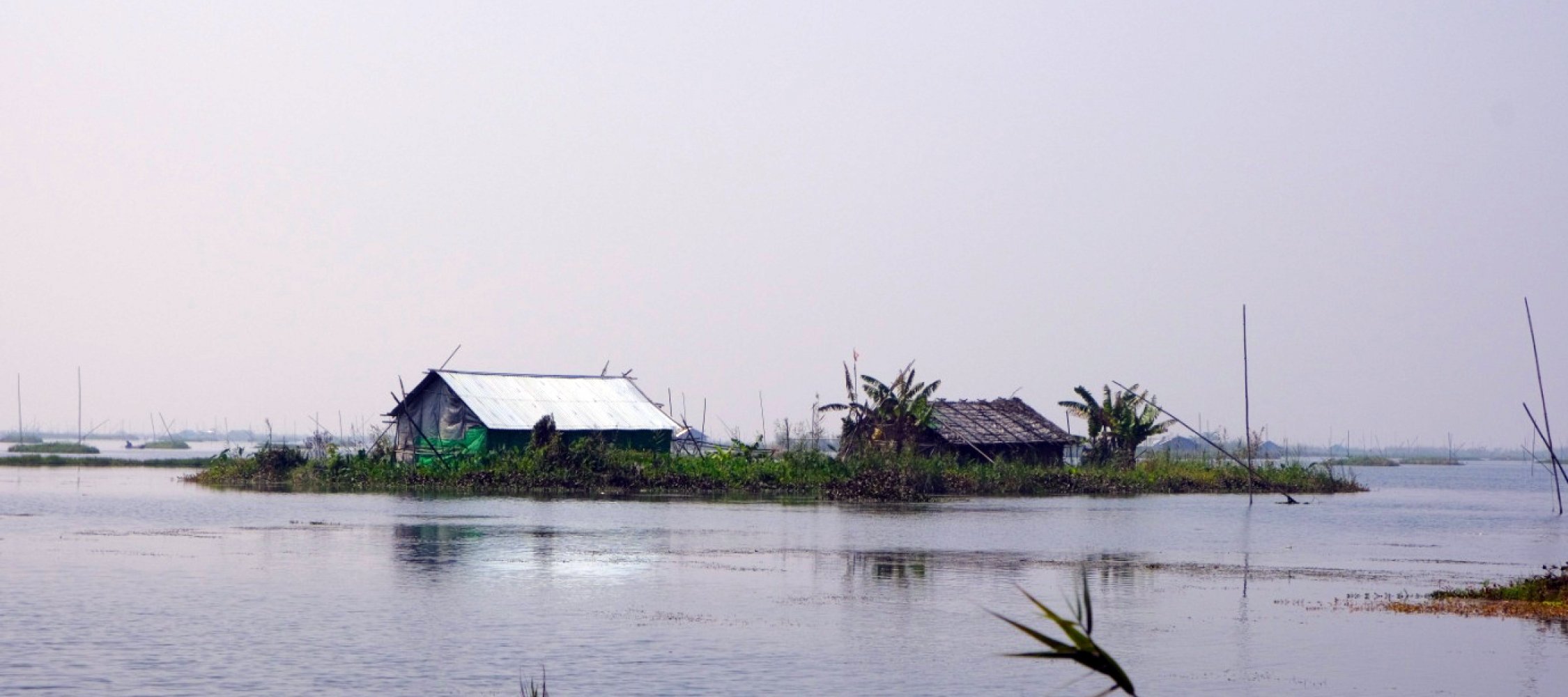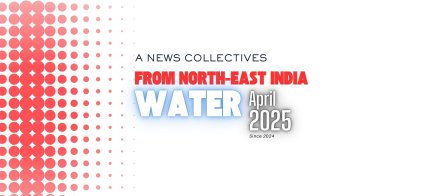 |
The Gazetteer of Manipur of 1886, compiled during the British period, noted that the lake was dotted with floating islands used by the inhabitants for fishing, but there was no mention of huts. A century later, in 1986, Singh, K.H. observed 207 khangpok or floating huts. In the 1991 Census, the Government of Manipur listed 131 huts with 363 persons occupying them, while two years later, a DRDA report found 688 huts. In 1999, the Loktak Development Authority (LDA) enlisted around 800 khangpoks, including other floating huts that are not part of CK village. The 2011 Census registers all together 311 huts with a population of 832 people.
Currently, CK comprises some 166 floating huts with a population of about 500 persons that are connected, or should one say, separated by the sprawling waterscape. The majority of the fishing households living there are mostly from the islands that dot the lake.
Till the early 1980s, this vast water body was a natural, freshwater wetland system formed as a continuum of land and water. There is a network of small water bodies, which forms a part of the main Loktak wetlands. When water drains out during the lean season, many areas emerge as ‘land’ amidst smaller water bodies that dot this area. When the monsoon arrives, and water from the surrounding catchment areas begins to fill in, the whole area gets transformed into one vast water body. During the lean season, the floating vegetations or phumdis touch the ground and grow taller as they come in contact with the nutrient-rich soil. When the monsoon rain begins, water level rises along with the vegetation. The rivers that run through this lake find their way to join the Manipur river, thus acting as a cleansing system of the vegetation, waste, and silts. So, it is this cyclical system which locals call, Eka-Ekum that marks the seasonal ‘death’ and ‘rejuvenation’ of this wetlands system.
Like all Meitei traditional houses, almost all the huts face the east. The only inlet to the hut is a low single door, and windows are conspicuously absent. Cooking and drying of fish are done at a corner of the hut, and the rest of the space is used for sleeping, and storing the fishing equipment and the day’s catch. All the family members share this small enclosed place. Those who also have houses on the shore, their children usually stay there for their education. But those permanently based on the khangpok find it quite risky for their children to commute to school.
Gender-based division of labour is quite pronounced. Typically, men tend to confine themselves to do the ‘harder’ work with higher productivity. During the afternoon and till the evening, all the fishing gears are laid, and early in the morning, the gears are checked for fish. Women use lift-net, locally known as the nupi ill (ladies net), contributing to the production. It is usually the work of the housewives to look after the household needs and dispose of the day’s catch. One may possibly say that in fishing, gender categories could contribute toward long-term resource conservation by moderating the total amount of harvest.
Loktak has been the main source of indigenous species of fish for the people in the valley. In 1992, it was estimated that almost 60 per cent of the fish catch of Manipur came from the Loktak lake alone, and more than 75 per cent of the state’s population consume fish, which is their main source of protein. But the scenario has changed as the indigenous varieties are almost wiped out by a human-designed ecosystem. Moreover, the Government of Manipur has introduced Indian major and exotic carp varieties like Rohu. With the loss of the indigenous varieties of fish species, one also finds the degradation of the original varieties of aquatic vegetation, which is also replaced by alien varieties, much to the disappointment of local people who depend on this edible aquatic flora for livelihood.
Loktak is the source of abundant aquatic edible flora – Yenna, Heikak, Loklei, Pullei, Komprek, Yellang, Thangjing, Ishing Kambong, Tharo, Thariktha, Thamchet, Peruk and Kengoi are some of the most used. Some of them seem to have disappeared, but now efforts are being made to re-grow them, especially, Heikak, a rice supplement, during difficult times. All these are consumed as well as sold in the market.
For khangpok families, fish is like currency – cash for fish; the hut dwellers sell their fish, earn cash, and then buy other essential stuff for the households from the market. So, living in the lake and fishing is quintessential. When the Ithai barrage was built, experts say, the pathway of freshwater fish was blocked; the barrage also disrupted the natural passage of fishes that came all the way from the Burmese water to lay eggs upstream in different parts of the river and wetlands in Manipur. Some of the fish species, which had been sacrificed were: Pengba-Tharak (Osteobrama belangeri), Ngara (tor tor gray), Mgatin (L. pangusia), Ngachik (Heteropneustus fossilis), Ngaton/Khabak (C. reba), Ngawa (Barilius barna), Sareng (Wallago attu), Ngahei (Eutropiichtys vacha), Ngatup (Neomacheilus), etc. People in the Manipur valley who are primarily fish eaters still swear by the traditional varieties of fishes that used to be available earlier. Now, Indian carp varieties have replaced indigenous freshwater fish.
Like all other nature-killing ingenious master craft of humankind known by its generic name dams, the Ithai barrage was built on the Manipur river that blocked the water of Loktak from flowing out. Nature was killed in 1983. Since then, the water level of Loktak has been maintained or sought to be maintained at a certain height to feed the three turbines of the National Hydroelectric Power Corporation (NHPC) run-Loktak Hydroelectric Project. It was “a multi-purpose storage scheme” that sought to harness the hydropower potential of the Loktak lake fed by the Khuga and Imphal rivers and provide lift irrigation for over 23,000 hectares of land in the valley.
Promises were also made to the communities that they would be adequately compensated, and the project would take appropriate measures for their socio-economic uplift. The promises were not kept, but the communities were also forced to move out of their home and hearth as all of their farmlands and homesteads went under the water of the reservoir. Subsequently, with the formation of LDA and the Manipur Loktak Lake (Protection) Act 2006, the entire wetlands – the traditional water commons – came under the complete control of the government, ignoring the historical claims and rights of the lake communities.
The Loktak-khangpok people, and others, who depend on the lake generally, are under threat from two main exogenous forces. One is from those who want to harness the lake’s waters for industrial development, and the other is from the conservation model.
After converting the natural lake into an artificial reservoir for hydropower generation – supposedly for transforming Manipur from an agricultural state into an industrial one – a series of ecological changes occurred. In the process, it marginalised those who have always been the guardian of the lake. With the water level kept at a constant level and with the proliferation of new and exotic aquatic vegetation, the traditional tools and fishing method has undergone some modifications and innovations. For example, the traditional fishing nets were small and made of simple cotton threads, but people now use larger nylon nets. The pressure to use bigger nets may have also arisen from the increase in population of the fishing families and rising demand for fish from the state population. This has led to overexploitation of fish, causing depletion in the fish population and disruption in the natural aquatic ecosystem. On top of this, many of the displaced families from the inundated agricultural lands had to take up fishing, and some decided to live on floating huts now permanently.
The pressure of the conservationist group can be observed from the local population’s resistance and protest against the demarcation of a large portion of the lake as the Keibul Lamjao National Park to protect the endangered Sangai, a brow-antlered deer found only in Manipur. An undated official leaflet reported that about 600 villagers from Thanga island attacked wildlife patrolling officers and burnt down the Khangadong-Khuningthek wildlife check post for treating them as encroachers. Local people were also not allowed to collect reeds and other materials used by them from the demarcated areas of the park, which used to be the traditional foraging grounds of the community. Loss of access to the community commons resulted in periodic conflicts.
Unfortunately, in November 2011, the state government burnt down 777 floating huts, including some of the huts in CK. The affected families managed to get a stay on the demolition drive after a writ petition (748 of 2011) was filed against it at the High Court of Manipur. During the stay, the fishing families rebuilt their huts and resumed their fishing activities. Subsequently, in its order on 11 December 2018, the high court also asked the LDA to hold an on-the-spot inquiry with the fisher folks and resolve this dispute. However, there has been no further action since this order.
Secondly, lack of proper toilet facilities is another problem; the residents usually dig a pit into the mass of floating phumdi, use them as toilets. The lake dwellers are often blamed for this unhygienic toilet practice, pointing out the direct flushing of human excreta into the lake as a reason for water contamination. The residents say they are fully aware of this problem, but they expect the government to find ways to solve it, as they do not know how to address this. Moreover, they are not the only ones responsible for water pollution. There are only a few hundred floating huts in the lake; in fact, all human waste comes from all around the lake and the adjacent urban locations of Imphal. Many lake residents also complained of back pain, eye problems, among other health issues.
Life is still uncertain as the government maintains its old position that those who live on the floating huts are occupiers/ encroachers. In June 2020, the Minister of Environment and Climate Change categorically stated in the local press that the local fishing community, which is polluting the lake, must be evicted.
Secondly, their right of residence is systematically denied by the state, showing them as mere encroachers or occupiers of the lake and not as persons in a floating village with rights to fishing and residence in the lake.
There are other issues too that need to be addressed:
i) Cleansing the water of the wetlands of all kinds of human waste, including plastics and other toxic pollutants, ensuring that urban and agricultural wastes do not reach the lake;
ii) Securing safe and clean drinking water for the lake dwellers;
iii) Finding suitable toilet solution for the khangpok residents and proper disposal of household waste. There are efforts to design new ways such as, using dry latrines where even biogas can be used from such a system;
iv) and finally, sustainable energy solution for cooking, fish drying and hut lighting, and charging mobiles. For that, solar solutions are being explored.
The battles are plenty, and a lot of energy is being spent on this effort. A union has been in place for almost a decade, and a new fishing cooperative has been established. Efforts are now underway for the election of the representatives to the ‘village authority’. The union has made submissions to the Inner Manipur MP to help recognise those engaged in capture fishery as fishers. They get similar legal protection as that of the forest dwellers under the LDA. A more significant challenge is to ensure that the Loktak Protection Act of 2006 is amended to conform to the Ramsar Convention and the National/ State Wetlands Rules 2014 to involve local communities in wetlands conservation. The people of CK are trying to tell the world that they are actual guardians of this wetland system and not the destroyer, as portrayed by the dominant conservation model.
Geolocation is 24.542074660061907, 93.80141922573732


